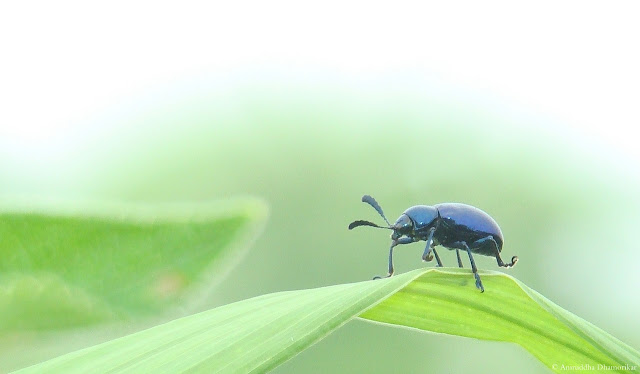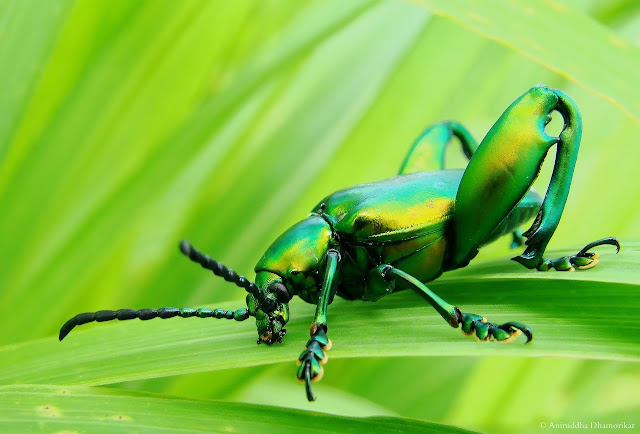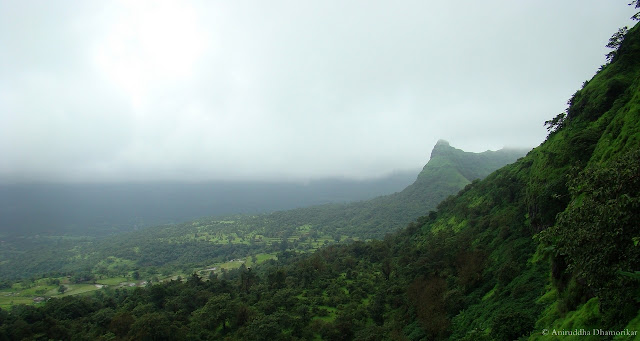On the last Sunday of July, I went hill-topping with fellow trekkers and naturalists to Tung Fort. Our aim was only one, to reach the very top come what may. We braved against the torrential rains, rode through a horde of tourists at the much more coveted waterfalls around the fort, forged our way through loose rocks and narrow cliffs and came face to face with a thousand waiting soldiers themselves. Nothing, nothing faltered us, not the rain neither the road traffic.
We began at 0600 Hours and reached the fort around 0800 Hours. It was a long drive through busy cities and deep valleys. Add some gray skies and bumpy roads, and you get a not-so-good start of what was expected to be a really exciting journey. Our mind pondered in depression, of whether we will see anything interesting, or even complete the trek. I was beginning to fall asleep already. I had to brave up to the sore throat and slight fever I had since the previous day. Whoever said that the journey matters more than the destination must have had considered an exception. And this was one.
When we finally reached the fort, all I saw was a huge expanse of rock standing almost vertical from the surface of the earth. Every facet of this natural fortification was alive. On top of it, carefully nestled, was the fort. It looked grandeur, something like this:
 |
| Tung Fort from the base |
I’m not sure where the name ‘Tung’ comes from, but it is also called Kathin-gad, literally meaning Difficult-fort. This was basically the only thing I knew about this fort. We didn’t know if it was kathin because it was difficult to trek, of if it was difficult to capture. This suspense made Tung seem even more formidable, yet exciting. I was eager to explore a new place (not that I’m tired of visiting Yeoor Hills). There is something about trekking forts. Every time you see it from distance, and every time you inch in closer to the heart of the fort, you feel more and more like a conqueror. It is not surprising to see people wave their hands in glory when they conquer, rather reach the pinnacle. I, too, felt proud, but in reality, this place was already conquered by a hundred, to your surprise, tiny creatures barely the size of your little finger nail (we’ll find out why a little later). It was their territory, probably even before the human emperor reached the top of this fort.
Once we reached the base, I was delighted to see the rain take a good day’s break. It was as if the clouds heard our prayers, but in reality it was so windy that clouds were pushed upward and away from this emergent fortress. In a way, it seemed as if the fort welcomed us. Not really us but our cameras, since we were going to conquer this fort anyway! So began our real part of the journey, and in this I agree with the phrase “it’s not the destination, but the journey that matters the most”, for our aim was not only to reach the end, but to explore the fort and observe the surrounding as carefully as possible.
This Fort is unique, in the sense not many tourists flock to this place. So the paths are slowly recaptured by the flora. It is also unique because if the elevation. All the forts in the Sahyadri Ranges of the Western Ghats house many endemics, seen only on the cliffs of such steep high-rise terrains.
As soon as we began to ascend, we saw not mosquitoes or weeds along the forest edges, but plants that flower only during Monsoon and flies that I had never seen before. The most common plants at the footstep of the Fort were Impatiens pulcherrima and Begonia crenata. The fort was dotted in plants that stood out from the otherwise small flora. It was the Wild Bananas, Ensete superbum:
 |
| Wild Banana inflorescence - Ensete superbum |
And to our delight, they were all flowering. The inflorescence of Bananas is huge – over a foot in diameter, and attracts a myriad of insects and birds for pollination. Wild Bananas are annual plants, dying out during late winter, but surviving as a root in the ground, and growing new shoots at the onset of monsoon. This large leaved plant not only added beauty to the landscape, but served as a great canvas for photographing insects up close.
As we slowly treaded through this wonderful thicket and steep little steps carved into the bedrock, we saw a rather unique flower, something I had never seen before, the Indian Grass Lily – Iphigenia indica:
 |
| Indian Grass Lily - Iphigenia indica |
According to
Flowers of India, this species is found only in elevations of about 1800 to 2000 feet; however Tung Fort is at an elevation of about 1074 feet. It is a rather unique looking plant in the family Liliaceae. All along the trail, there were a myriad of flowers, such as
Cyanotis tuberosa and one of my favorite ground orchids,
Habaneria sp.:
 |
| Habaneria sp. |
Habenaria are fairly common in such terrains, but this was the first time I ever observed them. They were everywhere I looked. There are over 800 described species of Habaneria found in both tropical and temperate zones (
Source). Besides this beautiful annual orchid, another white flowered plant that blooms only during this time of monsoon –
Chlorophytum glaucum was common on the steep side of the fort. A beautiful plant common the the Sahydaris was the Konkan Begonia,
Begonia concanensis but unlike the previous two that were mostly seen on the steep side of the trail, these were almost always seen on the opposite. Another little herb that looks something out of a painting is
Sonerila scapigera:
 |
| Sonerila scapigera |
These annual herbs are more so common in the northern Western Ghats, usually clinging onto large rocks with enough moss and algae growth to grab hold of the roots.
As we walked further and further, we viewed what every trekker cherishes – the great Dwar, or door of the fort. Just as we were approaching this dwar, a heavy load of clouds flew up from below and covered the valley in a bright white glow. It was one of the most awe inspiring moments of the trek. A gateway into the unknown. I did not know what to say. All I did was soak in the moment and capture it on my camera:
 |
| Main Entrance to the Fort |
We didn’t know what to expect inside the fort, which was, for most part, hauntingly beautiful. It turned into a spiritual experience, as much as this was a scientific expedition for us. I imagined horses riding in and out, of the large wooden doors supported by this stony edifice. The Fort then would have looked out worldly as it did that day. However, this is only one of the several avatars of the Dwar. In summer, it looks something like
this.
Once we entered this door, we knew we were stepping into something another worldly (exaggeration). It was, on a serious note, a different experience, and thanks to the plant that I’ve been wanting to see for years – Ceropegia sahyadrica lawii:
 |
| Ceropegia lawii and its faithful pollinators |
Thanks to my friend
Dinesh Valke who was always doubtful of the identity of this plant. It is an endangered plant that is endemic to the Sahyadri ranges of the Western Ghats. They were fairly common, growing extensively on the steep side of the fort. We could only see them because of their unusual flowers.
Ceropegia is an unlucky genus of plants in family Apocynaceae. Unlucky at least in the Western Ghats because of their delicacy, both in tolerance to pollution levels as well as a threat from over harvesting since their root is eaten. Therefore seeing one is a sure sign that the habitat is undisturbed and pristine.
A little further from the door, it opens into a large flat area, probably the main Hall of the fort. There are no high ceilings or big pillars anymore, and the ground is taken over by grasses and small herbs. Through this clearing we walked, and reached a temple. Beside the temple, guarding this temple, was an army ten thousand strong carrying a sword dipped in poison. Fortunately for us, they were too busy huddling together from the coldness that had gripped their territory. Plus we weren’t destroying their great possessions but merely admiring their beauty! It was a great colony of the Bees, Apis sp.:
 |
| Apis sp. beehive |
These bees are the ones responsible for keeping this fort alive, even after its main residents – the human conquerors have long perished. It is these guys and the flies, and beetles and birds that tend to this natural garden of nature. And we should be grateful of their free services. I came face-to-face with a beehive so close for the first time. I took a few photographs from far, and after realizing that they’re not intimidated by our presence, I decided to approach closer. The bees are not angry killing machines. They don’t just sting for no apparent reason; after all they don’t want to give up their lives just because you strayed too close. They usually give warning signals by creating a wave of fluttering wings over the surface of the hive, much like the wave created by football fans. It is a clear sign that they’re agitated, and we should back off. I wanted a picture where the frame was filled by the bees, and this is what I could manage:
 |
| How many bees in this frame? |
Just after this colony of soldiers was a tank of water. All the forts have one in India. This tank was a sight to behold:
 |
| A reservoir on the Fort |
It was not only surrounded by grasses, but Ceropegia, Habaneria, and a variety of other plants along its dripping walls. The water was alive as well, with dragonflies such as Red Marsh Trotter and female Darner laying eggs on the vegetable matter.
We were halfway through the trek. Now we had to cross two smaller pinnacles to reach the topmost. It wasn’t a long way to the top, but the biodiversity around here held us back. I have visited several forts in the Sahyadris, but this one was very special:
 |
| The Pinnacles |
As we slowly treaded, looking for plants and bugs, we reached the very top and were awestruck by the view from this fort:
 |
| View from the Fort - Pavana Lake |
The cloud line was just below us, and below it was a huge expanse of swollen body of water – the Pavana Lake. It is a lake resulting from the Pavana Dam. The lake is so huge that it can be seen in three directions from the fort. After taking several pictures of the landscape view, we resumed to something not many would do: extensive macro photography on the top of a fort!
 |
A member in the family Calliphoridae, hill-topping on the pinnacle. The large circles reflected off the cuticle is my
flash diffuser at work |
I was astonished to find such a diversity of insects on this highest point. What were they doing? Perhaps enjoying the view, like us? Perhaps yes, but they also had a really good reason to be here. These flies, beetles and butterflies were all waiting for someone. They were, what the scientists call, hill-topping. It is a behaviour where a male insect chooses the topmost point in an area, and then just sits and waits. Females that are ready to mate visit the male in his territory on the highest point. But it’s not that easy. There are several males of several species competing for the best spot on the pinnacle. So the competition is fierce, as we observed flies from different families fighting over a perch. I was amazed to see the diversity of flies here – from the common Flesh flies and Blue Bottle flies to the uncommon
Bengalia sp., and members in the genus of the families that I observed for the first time – Hybotidae and Rhagionidae. The Danaid Eggfly male butterflies were also seen at the top, but the wind was too intense to keep them put up on this high post. There was a lone bug too, one of the most colourful that I have ever seen:
 |
| A colourful Shield Bug, yet unidentified |
It belongs to the family Pentatomidae, the Shield Bugs family. I await its further identification. I wonder if he was hill-topping there. There were very few beetles around. A small Click Beetle was resting on a leaf, and a Leaf Beetle in the genus Chrysochus was walking around the grass blades as the fog covered the landscape:
 |
| A Leaf Beetle - Chrysochus sp. |
One of us sighted another amazing beetle as I was photographing the Chrysochus. It was, to my astonishment a Frog-legged Leaf Beetle, Sarga femorata:
 |
| Sagra femorata |
It was by far the most beautiful beetle I’ve seen this Monsoon. It was large and slow, so photographing this guy was easy and fun. If you remember, I spoke about Flea beetles in my
previous post, and this beetle also had large, fat hind legs, but I doubt if it used it for jumping like a flea, although they both belong to the same family of Chrysomelidae. I completely cherished the moment when I was at the highest point on a steep high-rise with one of the beautiful beetles. I spent a lot of time with my muse:
 |
| Sagra femorata showing the amazing antennae |
On the way up and down from the pinnacle, we were documenting several other insects as well, and especially those that were sitting on a wide banana leaf. One such pretty poses was given by an ant – the Polyrhachis sp.:
 |
| Polyrhachis sp. on a green canvas |
This ant is fairly common throughout the Western Ghats. Another ant that chose to sit under the banana leaf just as the sun glanced through the clouds was a Camponotus sp.:
 |
| Camponotus sp., under the banana leaf |
This ant was slow and cleaning itself off the rain drops. Yet another insect, this time a fly also posed on this green canvas:
 |
| Fungus Gnat posing on the green canvas |
It is a Fungus Gnat, in the family I don’t know. A male Stalk-eyed Fly who wouldn’t sit at one place on the leaf was also observed. A banana leaf, due to its large size, offers a best chance of photographing small insects since there isnt much clutter around, and instead of going for an awkward crop to avoid this clutter, your subject can occupuy a smaller area with a lot of negative space around. It is one of the ways to avoiding tighter crops, since tighter the crop, lesser the details in the subject.
Amongst Arachnids, the most commonly seen were Orb Weavers – Argiope sp., Neoscona sp., and Nephila sp. There were two Jumping Spiders that I saw on the pinnacle and absolutely adored, one of which, I think, is a Rhene sp.:
 |
| A probable Rhene sp., who enjoyed our attention |
Once we reached the bottom, a local told us that a few enthusiasts lost their lives while trekking the fort several weeks ago, which is very unfortunate. I wondered if this was really a kathin Fort and that is why it is called so. While we did not find this trek difficult, it is definitely a steep climb for those who’re not used to trekking. But I do recommend those who’re interested in exploring the biodiversity of Monsoon to explore such places – but please, no picking or killing anything! By keeping this place as untouched as possible is the only way to ensure its conservation.
 |
| The Sahyadris in monsoon |
I could not share all the pictures, nor could I write as much as I wanted to, since this has already turned into an overtly long report. We’ll look into the hill-topping behaviour and other interesting observations in much detail at the end of Monsoon. I’ll be writing every week this month, so do keep visiting!


Liked this account, as well the beautiful photographs.
ReplyDeleteThis entire post just took my breath away. The beauty and wonder you show is outstanding. The wild banana looked a lot like an artichoke to me.
ReplyDeleteLoved this post! I would absolutely love to spend a few days trekking through that area finding flies and taking photos! Absolutely gorgeous!
ReplyDeleteWonderful description buddy. The pics are simply breathtaking!
ReplyDeleteLoved the pics...especially the close up shots are simply amazing with such clarity & details...what camera are you using?
ReplyDelete